Tiancai Wang
Running VLAs at Real-time Speed
Oct 30, 2025Abstract:In this paper, we show how to run pi0-level multi-view VLA at 30Hz frame rate and at most 480Hz trajectory frequency using a single consumer GPU. This enables dynamic and real-time tasks that were previously believed to be unattainable by large VLA models. To achieve it, we introduce a bag of strategies to eliminate the overheads in model inference. The real-world experiment shows that the pi0 policy with our strategy achieves a 100% success rate in grasping a falling pen task. Based on the results, we further propose a full streaming inference framework for real-time robot control of VLA. Code is available at https://github.com/Dexmal/realtime-vla.
IntentionVLA: Generalizable and Efficient Embodied Intention Reasoning for Human-Robot Interaction
Oct 09, 2025Abstract:Vision-Language-Action (VLA) models leverage pretrained vision-language models (VLMs) to couple perception with robotic control, offering a promising path toward general-purpose embodied intelligence. However, current SOTA VLAs are primarily pretrained on multimodal tasks with limited relevance to embodied scenarios, and then finetuned to map explicit instructions to actions. Consequently, due to the lack of reasoning-intensive pretraining and reasoning-guided manipulation, these models are unable to perform implicit human intention reasoning required for complex, real-world interactions. To overcome these limitations, we propose \textbf{IntentionVLA}, a VLA framework with a curriculum training paradigm and an efficient inference mechanism. Our proposed method first leverages carefully designed reasoning data that combine intention inference, spatial grounding, and compact embodied reasoning, endowing the model with both reasoning and perception capabilities. In the following finetuning stage, IntentionVLA employs the compact reasoning outputs as contextual guidance for action generation, enabling fast inference under indirect instructions. Experimental results show that IntentionVLA substantially outperforms $\pi_0$, achieving 18\% higher success rates with direct instructions and 28\% higher than ECoT under intention instructions. On out-of-distribution intention tasks, IntentionVLA achieves over twice the success rate of all baselines, and further enables zero-shot human-robot interaction with 40\% success rate. These results highlight IntentionVLA as a promising paradigm for next-generation human-robot interaction (HRI) systems.
LLaDA-VLA: Vision Language Diffusion Action Models
Sep 10, 2025Abstract:The rapid progress of auto-regressive vision-language models (VLMs) has inspired growing interest in vision-language-action models (VLA) for robotic manipulation. Recently, masked diffusion models, a paradigm distinct from autoregressive models, have begun to demonstrate competitive performance in text generation and multimodal applications, leading to the development of a series of diffusion-based VLMs (d-VLMs). However, leveraging such models for robot policy learning remains largely unexplored. In this work, we present LLaDA-VLA, the first Vision-Language-Diffusion-Action model built upon pretrained d-VLMs for robotic manipulation. To effectively adapt d-VLMs to robotic domain, we introduce two key designs: (1) a localized special-token classification strategy that replaces full-vocabulary classification with special action token classification, reducing adaptation difficulty; (2) a hierarchical action-structured decoding strategy that decodes action sequences hierarchically considering the dependencies within and across actions. Extensive experiments demonstrate that LLaDA-VLA significantly outperforms state-of-the-art VLAs on both simulation and real-world robots.
MemoryVLA: Perceptual-Cognitive Memory in Vision-Language-Action Models for Robotic Manipulation
Aug 26, 2025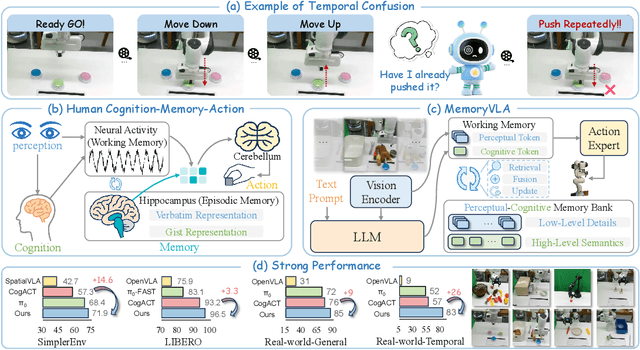
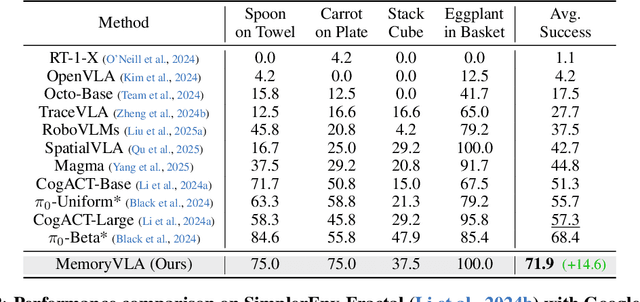
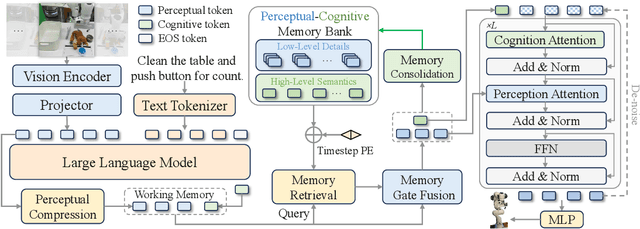
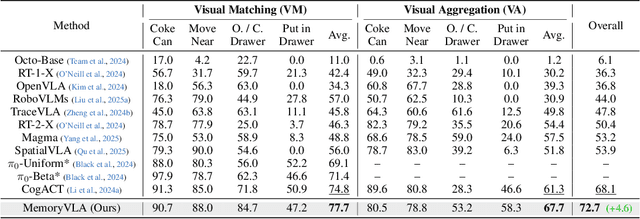
Abstract:Temporal context is essential for robotic manipulation because such tasks are inherently non-Markovian, yet mainstream VLA models typically overlook it and struggle with long-horizon, temporally dependent tasks. Cognitive science suggests that humans rely on working memory to buffer short-lived representations for immediate control, while the hippocampal system preserves verbatim episodic details and semantic gist of past experience for long-term memory. Inspired by these mechanisms, we propose MemoryVLA, a Cognition-Memory-Action framework for long-horizon robotic manipulation. A pretrained VLM encodes the observation into perceptual and cognitive tokens that form working memory, while a Perceptual-Cognitive Memory Bank stores low-level details and high-level semantics consolidated from it. Working memory retrieves decision-relevant entries from the bank, adaptively fuses them with current tokens, and updates the bank by merging redundancies. Using these tokens, a memory-conditioned diffusion action expert yields temporally aware action sequences. We evaluate MemoryVLA on 150+ simulation and real-world tasks across three robots. On SimplerEnv-Bridge, Fractal, and LIBERO-5 suites, it achieves 71.9%, 72.7%, and 96.5% success rates, respectively, all outperforming state-of-the-art baselines CogACT and pi-0, with a notable +14.6 gain on Bridge. On 12 real-world tasks spanning general skills and long-horizon temporal dependencies, MemoryVLA achieves 84.0% success rate, with long-horizon tasks showing a +26 improvement over state-of-the-art baseline. Project Page: https://shihao1895.github.io/MemoryVLA
GeoVLA: Empowering 3D Representations in Vision-Language-Action Models
Aug 12, 2025Abstract:Vision-Language-Action (VLA) models have emerged as a promising approach for enabling robots to follow language instructions and predict corresponding actions.However, current VLA models mainly rely on 2D visual inputs, neglecting the rich geometric information in the 3D physical world, which limits their spatial awareness and adaptability. In this paper, we present GeoVLA, a novel VLA framework that effectively integrates 3D information to advance robotic manipulation. It uses a vision-language model (VLM) to process images and language instructions,extracting fused vision-language embeddings. In parallel, it converts depth maps into point clouds and employs a customized point encoder, called Point Embedding Network, to generate 3D geometric embeddings independently. These produced embeddings are then concatenated and processed by our proposed spatial-aware action expert, called 3D-enhanced Action Expert, which combines information from different sensor modalities to produce precise action sequences. Through extensive experiments in both simulation and real-world environments, GeoVLA demonstrates superior performance and robustness. It achieves state-of-the-art results in the LIBERO and ManiSkill2 simulation benchmarks and shows remarkable robustness in real-world tasks requiring height adaptability, scale awareness and viewpoint invariance.
RAGNet: Large-scale Reasoning-based Affordance Segmentation Benchmark towards General Grasping
Jul 31, 2025


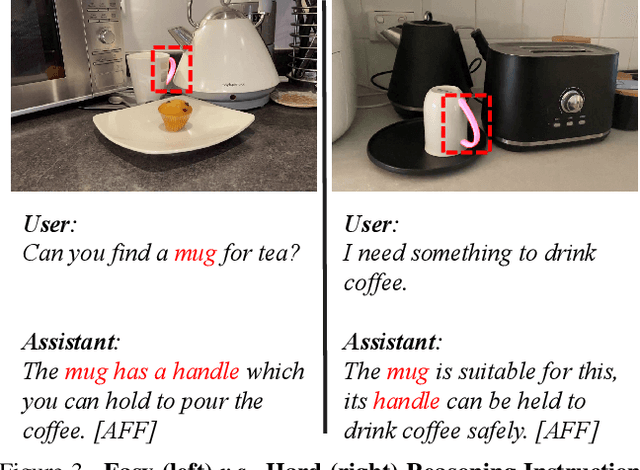
Abstract:General robotic grasping systems require accurate object affordance perception in diverse open-world scenarios following human instructions. However, current studies suffer from the problem of lacking reasoning-based large-scale affordance prediction data, leading to considerable concern about open-world effectiveness. To address this limitation, we build a large-scale grasping-oriented affordance segmentation benchmark with human-like instructions, named RAGNet. It contains 273k images, 180 categories, and 26k reasoning instructions. The images cover diverse embodied data domains, such as wild, robot, ego-centric, and even simulation data. They are carefully annotated with an affordance map, while the difficulty of language instructions is largely increased by removing their category name and only providing functional descriptions. Furthermore, we propose a comprehensive affordance-based grasping framework, named AffordanceNet, which consists of a VLM pre-trained on our massive affordance data and a grasping network that conditions an affordance map to grasp the target. Extensive experiments on affordance segmentation benchmarks and real-robot manipulation tasks show that our model has a powerful open-world generalization ability. Our data and code is available at https://github.com/wudongming97/AffordanceNet.
Holistic Tokenizer for Autoregressive Image Generation
Jul 03, 2025Abstract:The vanilla autoregressive image generation model generates visual tokens in a step-by-step fashion, which limits the ability to capture holistic relationships among token sequences. Moreover, most visual tokenizers map local image patches into latent tokens, leading to limited global information. To address this, we introduce \textit{Hita}, a novel image tokenizer for autoregressive (AR) image generation. It introduces a holistic-to-local tokenization scheme with learnable holistic queries and local patch tokens. Besides, Hita incorporates two key strategies for improved alignment with the AR generation process: 1) it arranges a sequential structure with holistic tokens at the beginning followed by patch-level tokens while using causal attention to maintain awareness of previous tokens; and 2) before feeding the de-quantized tokens into the decoder, Hita adopts a lightweight fusion module to control information flow to prioritize holistic tokens. Extensive experiments show that Hita accelerates the training speed of AR generators and outperforms those trained with vanilla tokenizers, achieving \textbf{2.59 FID} and \textbf{281.9 IS} on the ImageNet benchmark. A detailed analysis of the holistic representation highlights its ability to capture global image properties such as textures, materials, and shapes. Additionally, Hita also demonstrates effectiveness in zero-shot style transfer and image in-painting. The code is available at \href{https://github.com/CVMI-Lab/Hita}{https://github.com/CVMI-Lab/Hita}
ROSA: Harnessing Robot States for Vision-Language and Action Alignment
Jun 16, 2025Abstract:Vision-Language-Action (VLA) models have recently made significant advance in multi-task, end-to-end robotic control, due to the strong generalization capabilities of Vision-Language Models (VLMs). A fundamental challenge in developing such models is effectively aligning the vision-language space with the robotic action space. Existing approaches typically rely on directly fine-tuning VLMs using expert demonstrations. However, this strategy suffers from a spatio-temporal gap, resulting in considerable data inefficiency and heavy reliance on human labor. Spatially, VLMs operate within a high-level semantic space, whereas robotic actions are grounded in low-level 3D physical space; temporally, VLMs primarily interpret the present, while VLA models anticipate future actions. To overcome these challenges, we propose a novel training paradigm, ROSA, which leverages robot state estimation to improve alignment between vision-language and action spaces. By integrating robot state estimation data obtained via an automated process, ROSA enables the VLA model to gain enhanced spatial understanding and self-awareness, thereby boosting performance and generalization. Extensive experiments in both simulated and real-world environments demonstrate the effectiveness of ROSA, particularly in low-data regimes.
Grounding Beyond Detection: Enhancing Contextual Understanding in Embodied 3D Grounding
Jun 05, 2025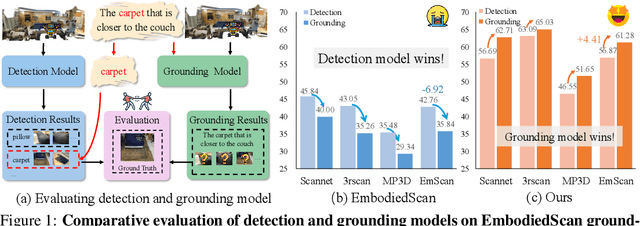

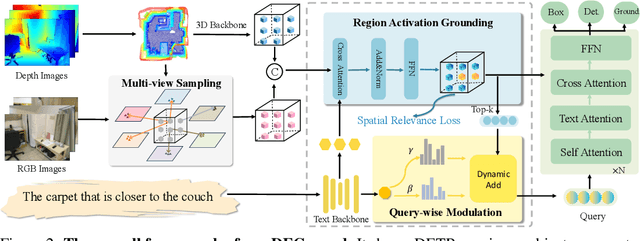

Abstract:Embodied 3D grounding aims to localize target objects described in human instructions from ego-centric viewpoint. Most methods typically follow a two-stage paradigm where a trained 3D detector's optimized backbone parameters are used to initialize a grounding model. In this study, we explore a fundamental question: Does embodied 3D grounding benefit enough from detection? To answer this question, we assess the grounding performance of detection models using predicted boxes filtered by the target category. Surprisingly, these detection models without any instruction-specific training outperform the grounding models explicitly trained with language instructions. This indicates that even category-level embodied 3D grounding may not be well resolved, let alone more fine-grained context-aware grounding. Motivated by this finding, we propose DEGround, which shares DETR queries as object representation for both DEtection and Grounding and enables the grounding to benefit from basic category classification and box detection. Based on this framework, we further introduce a regional activation grounding module that highlights instruction-related regions and a query-wise modulation module that incorporates sentence-level semantic into the query representation, strengthening the context-aware understanding of language instructions. Remarkably, DEGround outperforms state-of-the-art model BIP3D by 7.52\% at overall accuracy on the EmbodiedScan validation set. The source code will be publicly available at https://github.com/zyn213/DEGround.
PADriver: Towards Personalized Autonomous Driving
May 08, 2025Abstract:In this paper, we propose PADriver, a novel closed-loop framework for personalized autonomous driving (PAD). Built upon Multi-modal Large Language Model (MLLM), PADriver takes streaming frames and personalized textual prompts as inputs. It autoaggressively performs scene understanding, danger level estimation and action decision. The predicted danger level reflects the risk of the potential action and provides an explicit reference for the final action, which corresponds to the preset personalized prompt. Moreover, we construct a closed-loop benchmark named PAD-Highway based on Highway-Env simulator to comprehensively evaluate the decision performance under traffic rules. The dataset contains 250 hours videos with high-quality annotation to facilitate the development of PAD behavior analysis. Experimental results on the constructed benchmark show that PADriver outperforms state-of-the-art approaches on different evaluation metrics, and enables various driving modes.
 Add to Chrome
Add to Chrome Add to Firefox
Add to Firefox Add to Edge
Add to Edge